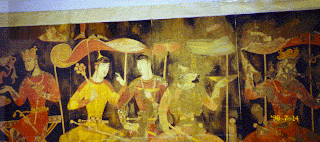I thought it was quite amazing to read up about how the Sogdian merchants alone were able to dominate pretty much all of the trade of the Silk Roads from the second century BC up until about tenth century AD, around the end of the Tang dynasty's era of rule. Just thinking about that time frame alone is pretty mind-boggling, especially considering the vastness of the Silk Road route, the number of various ethnic groups who traded around it, and the fact that it was plagued with attacks and excursions by bandits and other armed groups. To be able to overcome all those factors and still play a leading role in such an important economic route is nothing short of amazing for a group of people.
Although they did not seem to have much lasting luck in terms of their military power, they were still able to preserve their status as the dominant leaders of the entire Silk Road. Their language quickly became the common trade language along the route and their influence was key in aiding with the spread of religions along the Silk Road. It just goes to show that military power is not necessarily the only major influencing force that one can hold - economic and trade power is, I would argue, far more powerful than arms could ever hope to be.
They were, without a doubt, a very economic and trade-minded people. In a way, they were a 'gentler' version of more warlike groups. Whereas groups like that instilled the idea of combat and physical toughness with their younger members from an early age - training and conditioning them for combat - the Sogdian instead focused more on education and commercial skills from very early ages.
Their culture undoubtedly relished in the exposure it received to a variety of other cultures and goods. Being active traders, they were easily able to bring in resources and exotic goods from foreign cultures into their own. It's the main way that most cultures develop, evolve and change over time - influence and exposure to the ideas and goods of other cultures, which then get incorporated into one's own. The Sogdian did it themselves, to an extent - they aided with the spread of religions, and were actually key players in China and their quest for the Heavenly Horses (see post).
In 'return', Chinese artistic influence - wall-painting, for example - came upon Sogdian art
It's interesting to see how these 'trade-offs' work between cultures - each one influencing each other in some way, in a variety of degrees. For the Sogdian, they were perhaps a key player in aiding China with achieving considerable military power with their calvary units. In return, the Sogdian flourished under their trader-based cultural lifestyle and had personal developments with their arts and ideas.
They were, without a doubt, a very economic and trade-minded people. In a way, they were a 'gentler' version of more warlike groups. Whereas groups like that instilled the idea of combat and physical toughness with their younger members from an early age - training and conditioning them for combat - the Sogdian instead focused more on education and commercial skills from very early ages.
Their culture undoubtedly relished in the exposure it received to a variety of other cultures and goods. Being active traders, they were easily able to bring in resources and exotic goods from foreign cultures into their own. It's the main way that most cultures develop, evolve and change over time - influence and exposure to the ideas and goods of other cultures, which then get incorporated into one's own. The Sogdian did it themselves, to an extent - they aided with the spread of religions, and were actually key players in China and their quest for the Heavenly Horses (see post).
In 'return', Chinese artistic influence - wall-painting, for example - came upon Sogdian art
It's interesting to see how these 'trade-offs' work between cultures - each one influencing each other in some way, in a variety of degrees. For the Sogdian, they were perhaps a key player in aiding China with achieving considerable military power with their calvary units. In return, the Sogdian flourished under their trader-based cultural lifestyle and had personal developments with their arts and ideas.





No comments:
Post a Comment